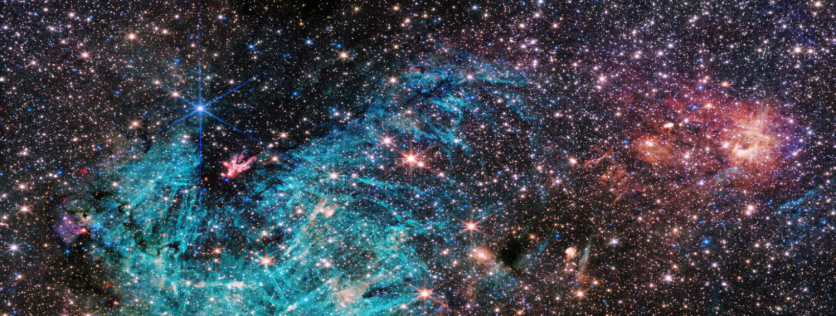NASA's James Webb Space Telescope has delved into the heart of the Milky Way, capturing an unprecedented image of the dense center of our galaxy. Our galaxy has never looked this electric and extremely detailed thanks to Webb's powerful infrared eyes.
The focus of this striking image is Sagittarius C (Sgr C), a star-forming region situated approximately 300 light-years away from the central supermassive black hole, Sagittarius A*.

Milky Way's Extreme Environment
Webb reveals never-before-seen features within the galactic center, leaving astronomers with intriguing puzzles to solve. Samuel Crowe, an undergraduate student at the University of Virginia in Charlottesville and the principal investigator of the observation team, expressed excitement about the level of resolution and sensitivity provided by Webb.
"Webb reveals an incredible amount of detail, allowing us to study star formation in this sort of environment in a way that wasn't possible previously," Crowe said in a statement.
Professor Jonathan Tan, one of Crowe's advisors, emphasizes the significance of studying the galactic center, describing it as the most extreme environment in our Milky Way galaxy. This region serves as a rigorous testing ground for current theories of star formation.
The image brims with an estimated 500,000 stars, or considered a cluster of protostars. These are stars in the process of formation, generating outflows that glow like a celestial bonfire within an infrared-dark cloud. At the center of this young cluster resides a massive protostar, surpassing 30 times the mass of our Sun, according to NASA.
The density of the surrounding cloud is so intense that light from stars positioned behind it cannot reach the telescope, creating the illusion of a less crowded area when, in reality, it is one of the most densely packed regions in the image. Small infrared-dark clouds, resembling voids in the starfield, mark locations where future stars are taking shape.
Read Also : New Computer Simulation Sheds Light on Early Galaxy Formation Aligned With NASA James Webb's Observations
Surprising Features
The NIRCam (Near-Infrared Camera) instrument on Webb captured large-scale emission from ionized hydrogen, displayed in cyan hues, enveloping the lower side of the dark cloud.
The extensive scope of this area is usually linked to energetic photons discharged by young massive stars but Webb reveals a surprising aspect that demands further exploration, according to the researchers.
Additionally, the image showcases needle-like structures within the ionized hydrogen, arranged in seemingly chaotic directions. This feature, among others, contributes to the complex and turbulent nature of the galactic center, a dynamic environment where magnetized gas clouds form stars, impacting the surrounding gas with their outflowing winds, jets, and radiation.
Situated approximately 25,000 light-years from Earth, the galactic center's proximity allows the James Webb Space Telescope to study individual stars in unprecedented detail. This proximity enables astronomers to glean valuable insights into the intricacies of star formation, examining how the process may vary in different cosmic environments throughout the galaxy.
The galactic center, with its turbulent and crowded nature, serves as a unique laboratory for unraveling the cosmic origin stories of stars and heavy elements that shape the universe.
Related Article : NASA James Webb Achieves One of Its First Major Science Goals After Probing the Atmosphere of TRAPPIST Planet

ⓒ 2025 TECHTIMES.com All rights reserved. Do not reproduce without permission.

![Best Gaming Mouse For Gamers With Smaller Hands [2025]](https://d.techtimes.com/en/full/461466/best-gaming-mouse-gamers-smaller-hands-2025.png?w=184&h=103&f=6fd057ef777bd39251d4e7e82e9b23f1)


